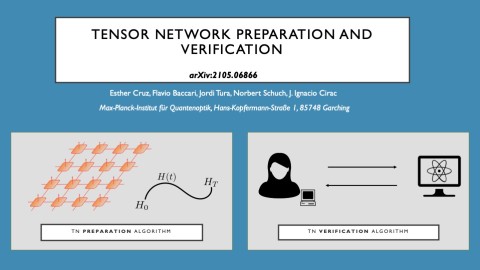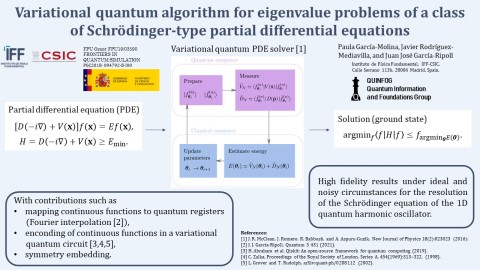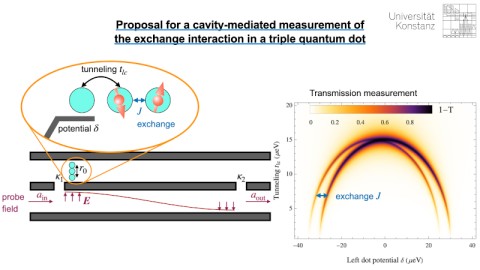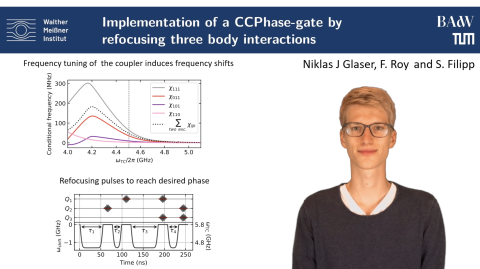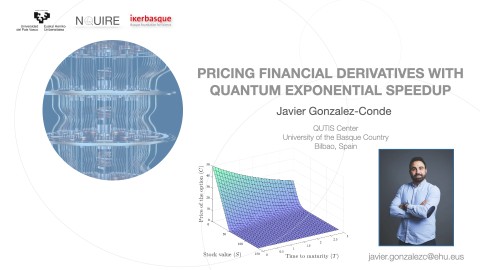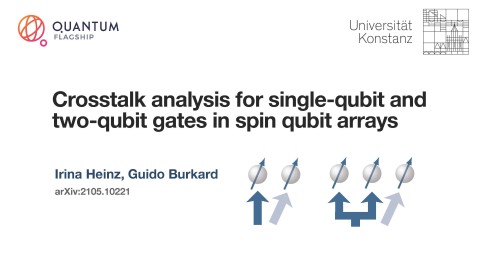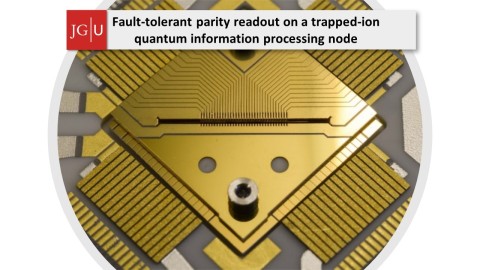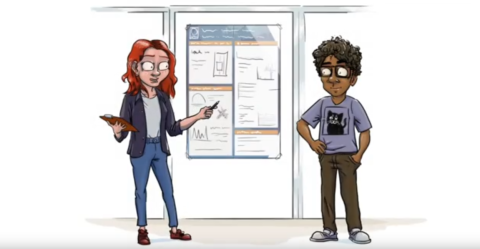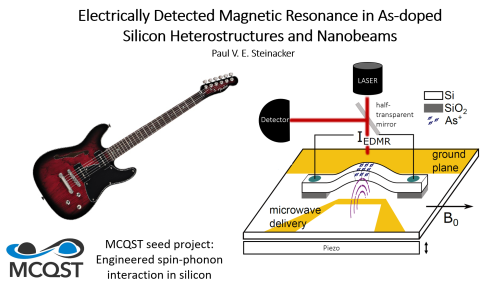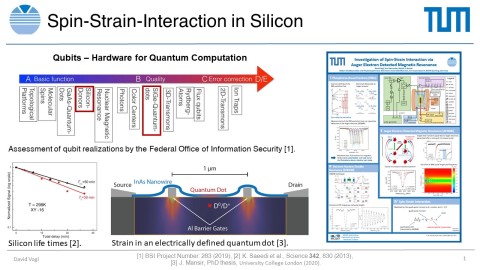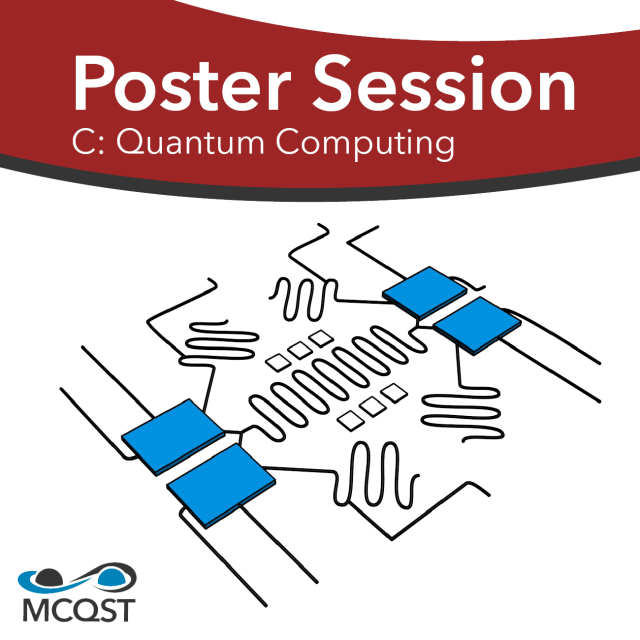
C. Quantum Computing
Poster Session I | All posters are presenting
Monday, 19 July 18:00 - 19:30 CEST
Poster Session II | All posters are presenting
Wednesday, 21 July 11:00 - 12:30 CEST
Abstract
Preparation and verification of tensor network states
n this work we propose an algorithm for the preparation and verification of ground states of local, gapped and frustration-free Hamiltonians in near-term devices, by means of an adiabatic algorithm. Our method works by smoothly deforming an adiabatic path of commuting Hamiltonians, such that a spectral gap is preserved. The family of proposed states includes all injective, isometric MPS and PEPS as well as paradigmatic states in 2D such as graph states. For each Hamiltonian, we provide a uniform bound for its spectral gap along the adiabatic path, thus guaranteeing the efficiency of the algorithm. Moreover, we study a potential useful application for our algorithm, namely a verification protocol which could potentially be used for the generation of certifiable randomness. This protocol works as a two-player game, in which a classical, limited verifier and a quantum prover communicate through a classical channel. The prover returns samples that result from measuring the ground state on a certain basis and must convince the verifier that they come from the correct distribution.
Authors: Esther Cruz (1), Flavio Baccari (1), Jordi Tura (1,2), Norbert Schuch (1,3), J. Ignacio Cirac (1)
Affiliations: (1) Max-Planck-Institute of Quantum Optics, Hans-Kopfermann-Straße 1, 85748 Garching, Germany, and Munich Center for Quantum Science and Technology, Schellingstraße 4, 80799 Muenchen, Germany (2) Instituut-Lorentz, Universiteit Leiden, P.O. Box 9506, 2300 RA Leiden, The Netherlands (3) University of Vienna, Faculty of Mathematics, Oskar-Morgenstern-Platz 1, 1090 Wien, Austria, and University of Vienna, Faculty of Physics, Boltzmanngasse 5, 1090 Wien, Austria
Abstract
Variational quantum algorithm for eigenvalue problems of a class of Schrödinger-type partial differential equations
In this work, we develop a variational quantum algorithm to solve partial differential equations (PDE's) using a space-efficient variational ansatz that merges structured quantum circuits for coarse-graining with Fourier-based interpolation. We implement variational circuits to represent symmetrical smooth functions as the ansatz and combine them with classical optimizers that differ on the gradient calculation: no gradient, numerical gradient and analytic gradient. We apply this method to the computation of the ground state of the one-dimensional quantum harmonic oscillator and the transmon qubit. In idealized quantum computers, we show that the harmonic oscillator can be solved with an infidelity of order 10^(-5)with 3 qubits and the transmon qubit with an error of order 10^(-4) with 4 qubits. We find that these fidelities can be approached in real noisy quantum computers, either directly or through error mitigation techniques. However, we also find that the precision in the estimate of the eigenvalues is still sub-par with other classical methods, suggesting the need for better strategies in the optimization and the evaluation of the cost function itself.
Authors: Paula García-Molina (1), Javier Rodríguez-Mediavilla (1), and Juan José García-Ripoll (1)
Affiliations: Instituto de Física Fundamental, IFF-CSIC, Calle Serrano 113b, 28006 Madrid, Spain.
Abstract
Proposal for a cavity-mediated measurement of the exchange interaction in a triple quantum dot
The exchange interaction between electrons in adjacent quantum dots (QDs) is a crucial ingredient for semiconductor spin qubits. Here, we propose a simple scheme to characterize the exchange interaction in a given QD device. We investigate theoretically the transmission of a microwave resonator coupled to a triple QD occupied by two electrons. We assume that the right QD is always occupied by one electron while the second electron can tunnel between the left and center QD. If the two electrons are in adjacent dots they interact via the exchange coupling. By means of exact analytical expressions we show that the transmission profile directly reveals the value of the exchange coupling strength between two electrons. From perturbation theory up to second order we conclude that the exchange can still be identified in the presence of magnetic gradients. In case of a lifted valley degeneracy prior knowledge about the valley splitting and phase differences is important to correctly identify the transmission dips and thus the exchange coupling.
Authors: Florian Ginzel (1) and Guido Burkard (1)
Affiliations: (1) Department of Physics, University of Konstanz, D-78457 Konstanz, Germany
Abstract
Implementation of a CCPhase gate by refocusing three-body interactions
Many applications for noisy intermediate scale quantum (NISQ) computing devices require entanglement over a large number of qubits. To generate these entangling operations, the community has mostly relied on 2-qubit entangling operations. However, being able to access and control strong n-body interactions involving multiple qubits can significantly improve the capabilities of a device. We study in numerical simulations three qubits connected to a tunable bus and demonstrate the control of two-body and three-body interactions. With appropriate refocusing of the interaction terms we can access the full parametric family of the Conditional-Conditional-Phase (CCPhase) gate with fidelity above 99 % in times between 200 ns and 300 ns.
Authors: (1) Walther-Meißner-Institut, Bayerische Akademie der Wissenschaften, Germany (2) Department of Physics, Technical University of Munich, Germany (3) Theoretical Physics, Saarland University, Germany (4) Munich Center for Quantum Science and Technology (MCQST), Germany
Affiliations: Niklas J Glaser (1, 2), F. Roy (1,2,3), S. Filipp (1, 2,4)
Abstract
Pricing Financial Derivatives With Exponential Quantum Speedup
Pricing financial derivatives is a relevant financial problem. The dynamics describing the price of vanilla options when constant volatilities and interest rates are assumed, is governed by the Black-Scholes model (1). Here, we present a digital quantum algorithm based on Hamiltonian simulation to solve Black-Scholes equation on a quantum computer by mapping it to the Schrödinger equation (2). The non-Hermitian nature of the resulting Hamiltonian is solved by embedding the dynamics into an enlarged Hilbert space, which makes use of only one additional ancillary qubit. Moreover, we employ a second ancillary qubit to transform initial condition into periodic boundary conditions, which substantially improves the stability and performance of the protocol. Our algorithm remarkably provides an exponential speedup since the terms in the Hamiltonian can be truncated by a polynomial number of interactions while keeping the error bounded. We report expected accuracy levels comparable to classical numerical algorithms by using 10 qubits and 94 entangling gates to simulate its dynamics on a faulttolerant quantum computer, and an expected success probability of the post-selection procedure due to the embedding protocol above 60%. (1) F. Black and M. Scholes The Journal of Political Economy 81 (1973). (2) J. Gonzalez-Conde et al, arXiv:2101.04023 (2021).
Authors: Javier Gonzalez-Conde (1,2), Ángel Rodríguez-Rozas (3), Enrique Solano (1,4,5,6), and Mikel Sanz (1,4,7)
Affiliations: (1) Department of Physical Chemistry, university of the Basque Country UPV/EHU, Apartado 644, 48090 Bilbao, Spain (2) Quantum Mads, Uribitarte Kalea 6, 48001 Bilbao, Spain (3) Risk Division, Banco Santander, Avenida Cantabria S/N, 28660 Boadilla del Monte, Madrid, Spain (4) IKERBASQUE, Basque Foundation for Science, Plaza Euskadi 5, 48009, Bilbao, Spain (5) International Center of Quantum Artificial Intelligence for Science and Technology (QuArtist) and Department of Physics, Shanghai University, 200444 Shanghai China (6) Kipu Quantum, Kurwenalstrasse 1, 80804 Munich, Germany (7) IQM, Nymphenburgerstr. 86, 80636 Munich, Germany
C.7 Irina Heinz
University of Konstanz
Abstract
Crosstalk analysis for single-qubit and two-qubit gates in spin qubit arrays
Scaling up spin qubit systems requires high-fidelity single-qubit and two-qubit gates. Gate fidelities exceeding 98% were already demonstrated in silicon based single and double quantum dots, whereas for the realization of larger qubit arrays crosstalk effects on neighboring qubits must be taken into account. We analyze qubit fidelities impacted by crosstalk when performing single-qubit and two-qubit operations on neighbor qubits with a simple Heisenberg model. Furthermore we propose conditions for driving fields to robustly synchronize Rabi oscillations and avoid crosstalk effects. In our analysis we also consider crosstalk on two neighbors and show that double synchronization leads to a restricted choice for the driving field strength, exchange interaction, and thus gate time. Considering realistic experimental conditions, we propose a set of parameter values to perform a nearly crosstalk-free CNOT gate and so open up the pathway to scalable quantum computing devices.
Authors: Irina Heinz, Guido Burkard
Affiliations: University of Konstanz
Abstract
Fault-tolerant parity readout on a trapped-ion quantum information processing node
Trapped ion quantum technology is among the most promising candidates for the realization of a scalable quantum processor. To address individual ions and perform high-fidelity two-qubit entangling gates in a linear segmented Paul trap, we employ dynamical register reconfiguration operations to place specific qubits in a laser interaction zone (1). To realize fault-tolerant quantum information processing, it is of crucial importance to be able to perform quantum error correction (2). One essential building block is to perform error syndrome readout, which allows the detection of errors through quantum non-demolition parity check measurements on the encoded states (3). We demonstrate a fault-tolerant weight-4 parity check measurement, using a shuttling-based quantum information processing node with four data and two ancilla qubits, reaching a flag-conditioned single-shot fidelity of 93.2(2) %. Additionally, we show the generation of six-qubit multipartite entanglement on all ions participating in this fault-tolerant parity readout circuit. (1) V. Kaushal et al., AVS Quantum Sci. 2, 014101 (2020) (2) A. Bermudez et al., Phys. Rev. X 7, 041061 (2017) (3) A. Rodriguez-Blanco et al., PRX Quantum 2, 020304 (2021)
Authors: (1) JGU Mainz, Institute of Physics, Staudingerweg 7, 55128 Mainz, Germany (2) Departemento de Fisica Teorica, Universidad Complutense, Madrid 28040, Spain (3) Institute for Quantum Information, RWTH Aachen University, D-52056 Aachen, Germany (4) Peter Grünberg Institute, Theoretical Nanoelectronics, Forschungszentrum Jülich, D-52425 Jülich, Germany
Affiliations: J. Hilder (1), D. Pijn (1), O. Onishchenko (1), A. Stahl (1), M.Orth (1), B. Lekitsch (1), A. Rodriguez-Blanco (2), M. Müller (3,4), F. Schmidt-Kaler (1) and U. G. Poschinger (1)
Abstract
Investigating Entanglement Rates of Coupled Superconducting Qubits Childcare
Fast two-qubit entangling gates are essential for quantum computers with finite coherence times. Due to the limit of interaction strength among qubits, there exists a theoretical speed limit for a given two-qubit entangling gate. This speed limit has been explicitly found only for a two-qubit system and under the assumption of negligible single qubit gate time. We also investigate a modified speed limit when single qubit gate time is not negligible, and achieve it experimentally on a superconducting qubit platform. Finally, we present a three-qubit device design aimed at demonstrating that coupling to additional qubits can significantly increase the speed limit of a two-qubit entangling gate, and discuss design implications for many-qubit processors.
Authors: J. Howard(1), K. Clark(1), C. Haack(1), A. Lidiak(1), T. McFadden(2), J. Long(2), M. Bal(2), T. Zhao(2), D. Pappas(2), Z. Gong(1), M. Singh(1)
Affiliations: 1: Colorado School of Mines 2: NIST Boulder
C.10 Pablo Antonio Moreno Casares
Universidad Complutense de Madrid
Abstract
QFold: Using Quantum Walks to tackle protein folding
We develop quantum computational tools to predict the 3D structure of proteins, one of the most important problems in current biochemical research. We explain how to combine recent deep learning advances with the well known technique of quantum walks applied to a Metropolis algorithm. The result, QFold, is a fully scalable hybrid quantum algorithm that, in contrast to previous quantum approaches, does not require a lattice model simplification and instead relies on the much more realistic assumption of parameterization in terms of torsion angles of the amino acids. We compare it with its classical analog for different annealing schedules and find a polynomial quantum advantage, and validate a proof-of-concept realization of the quantum Metropolis in IBMQ Casablanca quantum system.
Authors: P. A. M. Casares (1), Roberto Campos (1, 2), and M. A. Martin-Delgado (1, 3)
Affiliations: 1. Departamento de Física Teórica, Universidad Complutense de Madrid. 2. Quasar Science Resources, SL. 3. CCS-Center for Computational Simulation, Universidad Politécnica de Madrid.
C.11 Yuki Nojiri
Walther-Meissner-Institute
Abstract
High Quality Al/ AlO x /Al Resonator
Superconducting coplanar microwave resonators are an integral part of superconducting quantum processors and act as a test bed for developing fabrication technology. In the usual approach of fabricating resonators and superconducting qubit layer in separate steps, an extra resist step and interface cleaning between the two steps are required. Here, we investigate Al/AlOx/Al resonators, which can be fabricated in the same step as the qubits. Our goal is to determine the effect of the sandwiched oxide layer on the resonator quality factor. For suitable fabrication conditions, we observe internal quality factors on the order of 4×〖10〗^5. These results indicate that our fabrication conditions allow for a fabrication of qubits with lifetimes >10µs in the near future.
Authors: Kedar Honasoge (1,2) , Yuki Nojiri (1,2), Qi Ming Chen (1,2) , Florian Fesquet (1,2), Fabian Kronowetter (1,2) , Michael Renger (1,2), Mora Linda (3), Ralf Meyer (2,3), Oscar Gargiulo (1), Kirill G. Fedorov (1,2), Achim Marx (1), Rudolf Gross (1,2) , Frank Deppe (1,2)
Affiliations: (1) Walther Meißner Institute, Bavarian Academy of Sciences and Humanities , Germany (2) Physik Department, TU München, 85748 Garching, Germany (3) Walter Schottky Institute and Physik Department , TU München, 85748 Garching, Germany
Abstract
A Variational Quantum Adiabatic Algorithm
Preparing the ground state of a Hamiltonian is a problem of great significance in physics with deep implications in the field of combinatorial optimization. The adiabatic algorithm is known to return the ground state for sufficiently long preparation times which depend on the a priori unknown spectral gap. We present the concept of a variational quantum adiabatic algorithm (VQAA) for optimized adiabatic paths. We aim at combining the strengths of the adiabatic and the variational approaches for fast and high-fidelity ground state preparation while keeping the number of measurements as low as possible. Our algorithms build upon ancilla protocols which we present that allow to directly evaluate the ground state overlap. We benchmark for a non-integrable spin-1/2 transverse and longitudinal Ising chain with N=53 sites using tensor network techniques. Using a black box, gradient-based approach, we report a reduction in the total evolution time for a given desired ground state overlap by a factor of ten, which makes our method suitable for the limited decoherence time of noisy-intermediate scale quantum devices.
Authors: Benjamin F. Schiffer (1,2), Jordi Tura (3,1,2), J. Ignacio Cirac (1,2)
Affiliations: (1) Max-Planck-Institut für Quantenoptik, Hans-Kopfermann-Str. 1, D-85748 Garching, Germany (2) Munich Center for Quantum Science and Technology (MCQST), Schellingstr. 4, D-80799 Munich, Germany (3) Instituut-Lorentz, Universiteit Leiden, P.O. Box 9506, 2300 RA Leiden, The Netherlands
Abstract
Electrically Detected Magnetic Resonance in As-doped Silicon Heterostructures and Nanobeams
Here, the main results acquired throughout the last year in the scope of the seed funding project “Engineered spin-phonon interaction in silicon” are presented. The idea was to do fundamental research with the ultimate goal of demonstrating electrically detected magnetic resonance (EDMR) in a free-standing nanobeam of neutral arsenic-doped silicon. In a later iteration, donors could be ionized and acoustic modes excited by piezo actuators. Phononically induced strain fields couple via the electric field gradient (EFG) tensor to the nuclear spin system and the displacement amplitude of the beam can be read out with an interferometer. So far, EDMR could successfully be measured in a free-standing nanobeam of length l = 1000 nm, width w = 600 nm, and height h = 3 µm. The three relevant parameters for signal optimization proved to be, listed in order of importance, the signal amplitude ΔI, the contrast ΔI/I, and the signal-to-noise ratio SNR. Additionally, intentionally strained silicon/silicon-germanium heterostructures were analyzed. Under strain the six equivalent Si valleys are repopulated such that the hyperfine constant A is reduced and the g-factor becomes anisotropic. Measurements of the hyperfine constant via EDMR allow conclusions on the, which is only roughly a factor of two smaller than the value determined from Vegard’s law due to the lattice mismatch. Furthermore, the shift of the g-factor under rotation of the sample with respect to the magnetic field of about Δg = 5.29(1) · 10^-4 was observed, coinciding with theory of valley repopulation yielding Δg = 5.3(8) · 10^-4. The expected quadrupole interaction strength of around Q = 50 kHz, however, could not be resolved with EDMR measurements. Nuclear magnetic resonance (NMR), or more advanced experimental techniques like electron nuclear double resonance (ENDOR) and electrically detected electron-nuclear double resonance (EDENDOR) will give additional.
Authors: Paul V. E. Steinacker (1), David A. Vogl (1), Hans Huebl (2,3), and Martin S. Brandt (1,3)
Affiliations: (1) Walter Schottky Institut and Physik-Department, Technische Universität München, Am Coulombwall 4, 85748 Garching, Germany (2) Walther-Meißner-Institut, Bayerische Akademie der Wissenschaften, Walther-Meißner-Str. 8, 85748 Garching, Germany (3) Munich Center for Quantum Science and Technology, Schellingstr. 4, 80799 Munich, Germany
Abstract
Investigation of Spin-Strain Interactions via Auger Electron Detected Magnetic Resonance
Investigation of Spin-Strain Interactions via Auger Electron Detected Magnetic Resonance David Vogl, Paul Steinacker, Martin S. Brandt Walter Schottky Institut and Physik-Department, Technische Universität München, Am Coulombwall 4, 85748 Garching, Germany Chemical purification and isotope engineering allow to obtain Silicon crystals effectively containing no background spins. This makes 28Si or 30Si an ideal material for spin-based quantum storage and coherence times of tens of minutes even at room temperature have already been demonstrated for ionized donors in 28Si. We set up and investigate a technique for the initialization, manipulation, and readout of electron and nuclear spins of shallow Phosphorus donors in 28Si utilizing the spin-dependent and resonant excitation of donor-bound excitons and their successive Auger decay and detecting the Auger electrons capacitively. This method was first implemented by Thewalt and coworkers. We are able to selectively generate spin hyperpolarization of the 31P nuclei via cross relaxation, and have demonstrated coherent control of the nuclear spin via electron nuclear double resonance (ENDOR). This technique is also applicable to donors with nuclear spin higher than 1/2, which opens up the possibility of examining the quadrupolar interaction in more detail.
Authors: David Vogl, Paul Steinacker, Martin S. Brandt
Affiliations: Walter Schottky Institut, Technische Universität München


